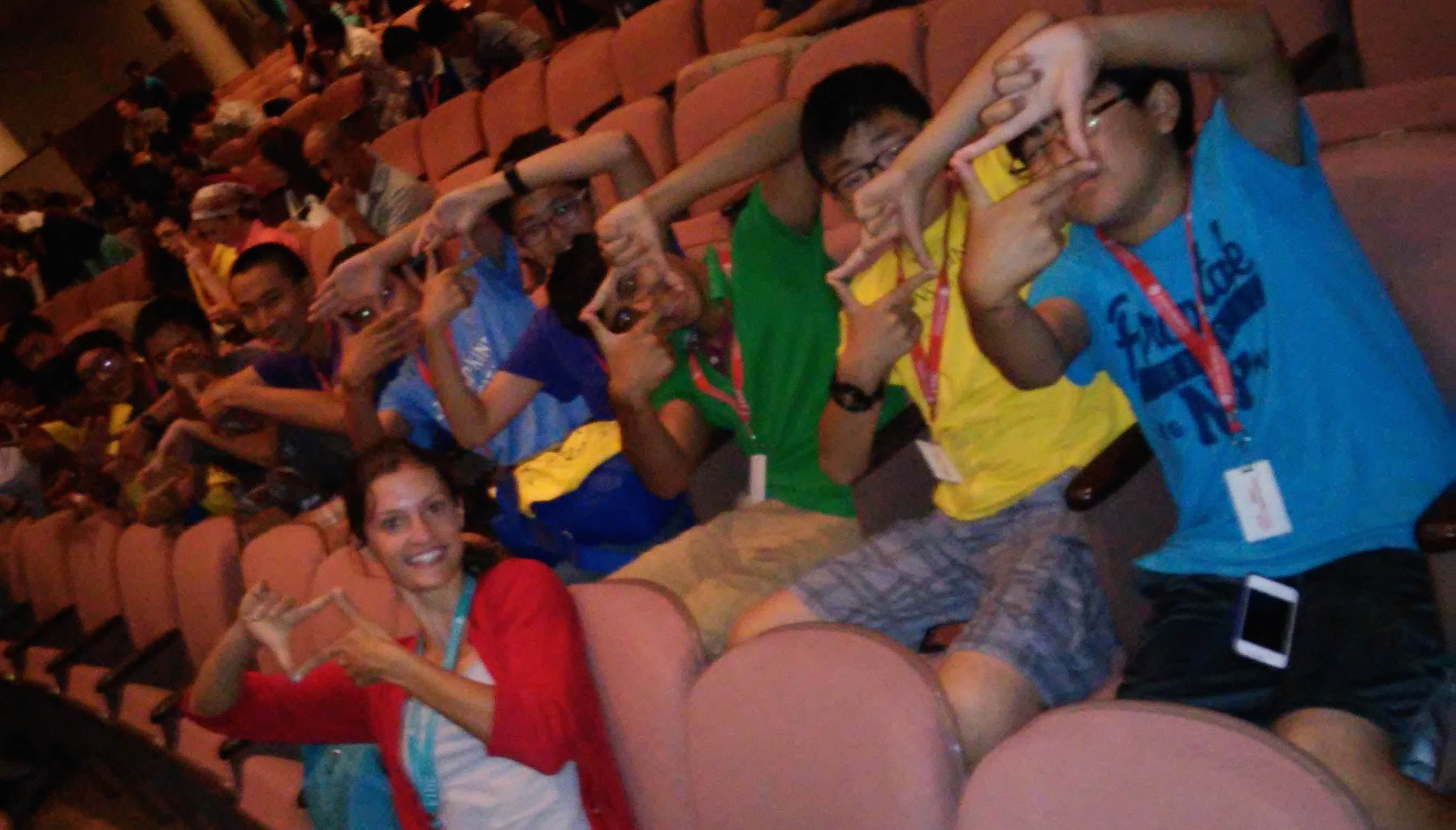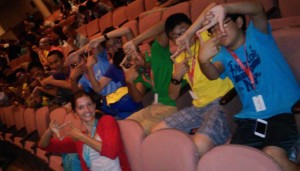This year’s Whiting Fellows in the Humanities are Maeve Doyle (History of Art) and Johanna Best (Classical and Near Eastern Archaeology). The Graduate Group in Archaeology, Classics and History of Art celebrated the recipients at its annual Whiting Fellows Presentation, October 21, 2014. The Fellows presented on their dissertation research and answered questions from a lively audience.
Category Archives: Awards and Publications
Summer Internship Spotlight: Kathryn Bryant and Hannah Schwartz
Pictured: Kathryn Bryant at CTY with her class, flashing the “theorem proved” sign!
Mathematics graduate students Hannah Schwartz and Kathryn Bryant served as teaching assistants for the Center for Talented Youth (CTY). CTY brings exceptionally bright middle- and high-schoolers together for three-week intensive academic programs. Graduate students, professors, teachers, and other professionals then teach undergraduate-level courses to these students, who are between 12 and 16 years of age. It is an internationally renowned program, and there are sites located at colleges and universities all around the U.S.. Hannah worked nearby at Haverford College for a program that explored the relevance of Math in Art; Kathryn participated in the program at Johns Hopkins University focusing on Mathematical Logic.
Hannah and Kathryn also attended a week-long workshop at the Institute for Computational and Experimental Research in Mathematics (ICERM) at Brown University. The topic was Combinatorial Link Homology Theories, Braids, and Contact Geometry, which relates both to Hannah’s masters’ research and Kathryn’s doctoral research.
GSAS Alumna to join National Academy
Naomi Halas, M.A. ‘84 and Ph. D. ‘87 in physics at Bryn Mawr College, was elected to join the National Academy of Engineering for her research in nanoscale engineering of optical resonances and lineshapes. Prof. Halas is currently the Stanley C. Moore Professor in Electrical and Computer Engineering and holds appointments as Professor of Biomedical Engineering, Chemistry, Physics & Astronomy at Rice University, Houston where she is also the Director of the Laboratory for Nanophotonics.
Halas’ PhD research was performed with Daniel Grischkowsky at IBM Yorktown in the area of ultrafast nonlinear optics and dark soliton generation, including work on the first terahertz time-domain spectroscopy efforts. Dr. Halas joined Rice University following her postdoctoral fellowship at AT&T Bell Laboratories, where she studied time-resolved photoemission spectroscopy on semiconductor surfaces.
She is the author of more than 200 refereed publications, has more than 15 issued and pending patents, and has presented more than 300 invited talks. She is best known scientifically in the field of plasmonics as the inventor of tunable nanoparticles with resonances that span the visible and infrared regions of the spectrum, studying their properties and pursuing applications in biomedicine, chemical sensing, and energy.
Dr. Halas is co-founder of Nanospectra Biosciences, Inc., a company currently commercializing a photothermal cancer therapy based on her nanoparticles. She is founder and Director of the Laboratory for Nanophotonics (LANP) at Rice, which supports collaborations and interactions among researchers at Rice and other institutions nationally and internationally in the field of Plasmon-based optics and applications. She is the Principal Investigator of an NSF-funded integrative graduate education and research training grant (IGERT) in Nanophotonics, the first such graduate training program in the U.S.
http://halas.rice.edu/halas-bio
Whiting Fellowship Presentations-Tuesday, October 29
Presentations by this year’s Whiting Fellows, Johanna Gosse (HArt) and Eleanor Mulhern (Classics).
Tuesday, October 29, at 5 p.m., Carpenter B21.
Reception from 6-7 p.m. in Carpenter atrium.
Chemists present research in Portugal
Sharon Burgmayer, W. Alton Jones Professor of Chemistry, and graduate students Benjamin Williams and Douglas Gisewhite traveled to Sintra, Portugal to participate in the international Conference on Molybdenum and Tungsten Enzymes. Both Prof. Burgmayer, who co-chaired the conference, and Ben Williams were invited to speak to present recent results from the Burgmayer labs.


